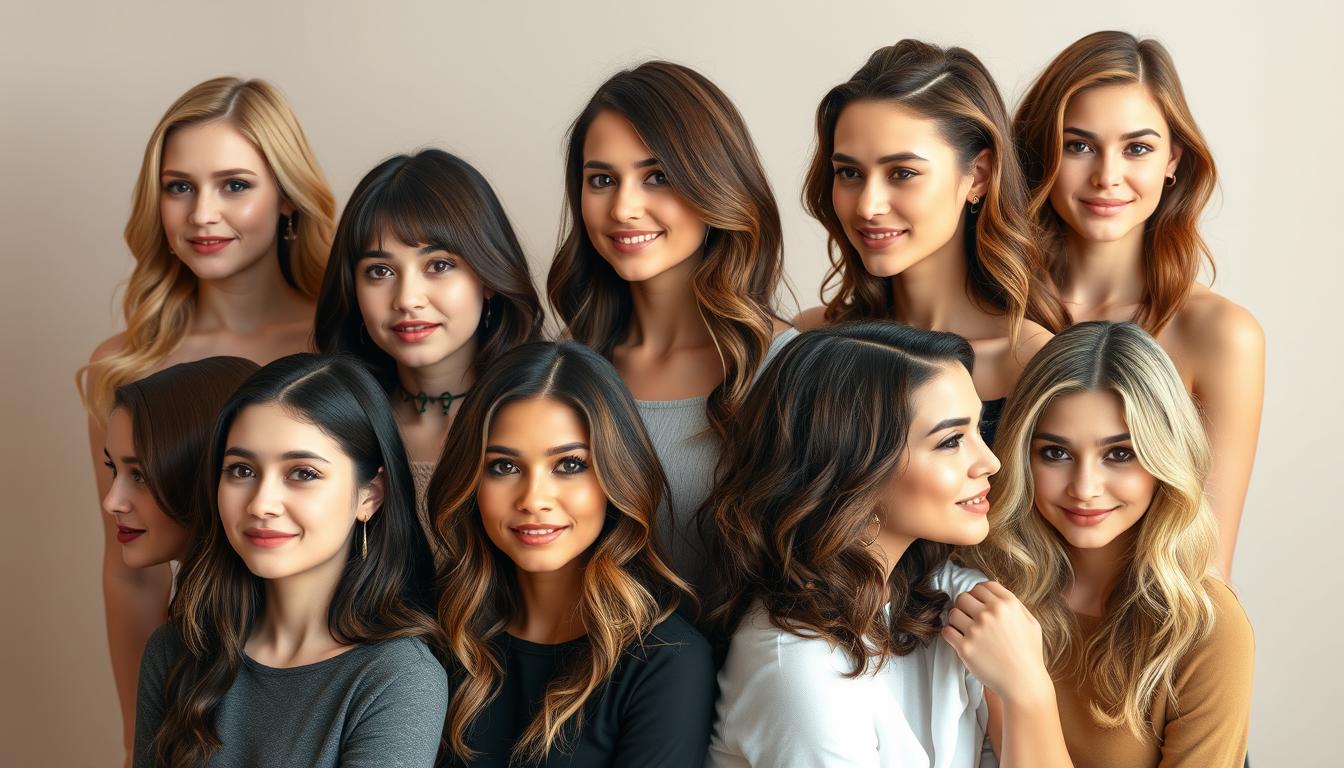Finding the right hair styles for women can change how you feel every day — boosting confidence and matching your personal style. Whether you’re leaning toward bold short cuts, versatile medium lengths, long flowing styles, or a customized cut, the key is choosing what works with your hair type and face shape. This guide lays out practical tips for picking a style that fits your hair, your lifestyle, and the look you want to create.
Read on for actionable advice on identifying your natural texture, selecting flattering cuts, and maintaining healthy hair so your new hairstyle always looks its best.
Choosing a hairstyle matters — it affects confidence, complements your personal style, and needs to fit your lifestyle. This guide covers short, medium, long, and customized cuts and explains how to match a look to your hair type, face shape, and daily routine so you can feel and look your best.
Throughout the article you’ll find practical, actionable tips: how to identify your natural hair type, which styles flatter different face shapes, and easy maintenance routines that work for busy women. Jump to the section that fits you — hair type, face shape, or length — and start experimenting with confidence.
Understanding Your Hair Type
Understanding hair types is the foundation for choosing hair styles that actually work for you. Hair falls into four broad categories—straight, wavy, curly, and coily—and each category has distinct behavior, manageability, and product needs. Knowing your hair texture and how it responds to humidity, brushing, and styling tools will help you pick cuts and routines that keep your hair healthy and looking its best.
1)Explain hair types: straight, wavy, curly, and coily.
Straight hair typically lies flat against the head, reflects light for natural shine, and can appear finer in body. Wavy hair forms an S-shape and gives more natural movement and volume. Curly hair makes defined ringlets or spirals that vary from loose to tight; it often needs extra moisture to avoid frizz. Coily hair (sometimes called kinky) has tight zigzag patterns and strong shrinkage; it offers incredible density and can be delicate, so gentle handling and protective styling work best.
2)Tips for identifying your natural hair texture and volume.
To identify your natural texture, wash your hair, skip styling products, and let it air-dry. Observe whether strands lie straight, form waves, curl, or coil — that’s your starting point. Check strand thickness by comparing a single hair against a thread (fine vs. medium vs. coarse), and judge volume by how much hair lifts at the roots when dry. Also test porosity: drop a clean strand in water — if it sinks fast, it’s high porosity and needs more moisture; if it floats, it’s lower porosity and resists moisture.
Quick signs: fine hair often lacks long-lasting volume, while thick hair holds shape and benefits from thinning or layering to reduce bulk. If you have curly hair or coily textures, look for curl definition and pattern (loose, spiral, or tight coil) to choose a cut that enhances the natural curl.
3)How hair type influences the best hair styles for women.
Your hair type should guide cut and styling choices. Straight hair often suits sleek bobs and blunt cuts that emphasize shine; thin, straight hair can gain perceived fullness with a blunt edge. Wavy hair works well with long layers and beachy textures that play up movement. Curly and coily hair typically benefits from strategic layered cuts that reduce bulk and create shape without sacrificing curl pattern. For thick hair, long layers or texturizing techniques add movement; for fine hair, shorter lengths or blunt ends can create more visible body.
Use these observations to jump to the Short, Medium, or Long sections for specific style and maintenance tips tailored to your texture and volume.
Choosing Hair Styles Based on Face Shape
Understanding your face shape is a practical way to choose hairstyles that enhance your best features. Common shapes—oval, round, square, and heart-shaped—respond differently to length, layers, and bangs, so picking the right cut helps create balance and a flattering overall look.

1) Oval, round, square, heart-shaped faces explained.
Face shape provides a framework for choosing cuts that complement your proportions:
- Oval: Slightly longer than wide with balanced proportions — almost any cut works well; try soft layers to keep movement without overwhelming the face.
- Round: Fuller cheeks and similar width and length — opt for styles that elongate, such as long layers or height at the crown to create the illusion of length.
- Square: Strong jawline and forehead with angular features — soften the angles with rounded cuts, side-swept bangs, or gentle waves around the face.
- Heart-shaped: Wider forehead tapering to a narrow chin — balance the forehead by adding face-framing layers, chin-length bobs, or side-swept bangs to draw attention downward.
2) Recommended hair cut styles for women with each face shape.
Use these practical style ideas to match your face shape:
| Face Shape | Recommended Hair Cut Styles |
|---|---|
| Oval | Long layers, soft waves, blunt cuts — most styles work well; add soft layers for movement. |
| Round | Long layers, asymmetrical bobs, high-volume tops — avoid full-width chin-length cuts; add length to elongate. |
| Square | Long layers with soft curls, side-swept bangs, rounded cuts — use layers to soften the jawline. |
| Heart-shaped | Face-framing layers, side-swept bangs, textured cuts — balance a wider forehead and add width at the chin. |
3) How to balance proportions with length and layers.
Balancing proportions is about choosing the right length and placing layers where they help your face shape:
- Measure quickly: forehead, cheekbones, jawline, and face length — longer faces benefit from width, round faces from added length.
- Round faces: add long layers and off-center parts; avoid one-length chin bobs that emphasize width.
- Square faces: use soft layers and side-swept bangs to break up angular lines; opt for rounded ends rather than blunt edges.
- Heart-shaped faces: add fullness around the chin with long layers or a textured bob to balance the forehead.
- Oval faces: keep proportions—try soft layers or blunt bobs depending on the amount of movement you want.
Quick CTA: Use this face-shape checklist when you talk to your stylist — mention the length and layer placement you want (for example, “long layers to elongate” or “face-framing layers around the chin”). Small adjustments in layers and parting can make a big difference in how a cut works with your face.
Short Hair Styles for Women
Short hair styles for women are a great way to express individuality while keeping a chic, modern profile. Standout options like the pixie cuts and bob styles work for many face shapes and hair types when tailored correctly — and asymmetrical cuts add an edgy, fashion-forward twist.
1)Popular styles: pixie cut, bob, asymmetrical cuts.
Pixie cuts are cropped and bold, drawing attention to facial features and working especially well with confident, low-fuss looks. The bob family ranges from chin-length blunts to longer lobs — a blunt bob can create the illusion of thicker hair and frames the face neatly. Asymmetrical cuts (longer on one side) bring movement and a contemporary silhouette that works well for straight or slightly wavy textures.
2)Benefits: easy maintenance, modern look, versatility.
Short cuts are generally lower maintenance: they dry faster, need less product, and are quicker to style each morning. They offer a modern aesthetic that can be polished or playful depending on how you style them. Versatility is a major benefit — a pixie or bob can be dressed up for events or tousled for casual days, making them a great way to refresh your look without a long-term commitment.
3)Styling tips and tools for short hair.
Styling short hair is simple with the right approach. Recommended tools and quick steps:
- Texturizing spray or salt spray — for effortless movement and separation.
- Lightweight wax or pomade — for definition; a pea-sized amount warmed between fingers works well for a textured pixie.
- Small round brush or vent brush — for adding lift at the roots on a bob during blow-drying.
Two quick how-tos: For a textured pixie, work a pea-sized dot of pomade through dry hair and tousle with your fingers. For a sleek blunt bob, smooth a heat protectant over damp hair and use a straightener or blow-dry with a round brush, finishing with a light shine serum. Trim recommendation: schedule maintenance every 4–6 weeks to keep the shape precise.

Medium Hair Styles for Women
Exploring medium hair styles for women is a great way to get both versatility and low-commitment change. Medium lengths — especially shoulder-length looks — lend themselves to layered cuts, soft layers, or blunt finishes depending on whether you want movement or structure. These lengths work well across hair types and let you switch between casual and polished styles with minimal effort.
1) Styles: layered cuts, shoulder-length straight or wavy styles.
Layered cuts add dimension and create movement, which is especially flattering on shoulder-length styles. A straight, shoulder-length cut reads sleek and professional; add long layers or soft layers and you get a relaxed, wavy look that’s easy to tousle. For a beachy, undone vibe, ask for subtle texturizing and slightly feathered ends so waves form naturally without looking over-styled.
2) Benefits: flexible styling, suits multiple face shapes.
Medium hair styles for women are flexible — you can wear them straight, in loose waves, in a half-up twist, or in a low bun. Because of that flexibility, these cuts work well for many face shapes: long layers can balance round faces, while a blunt shoulder-length can emphasize an oval face’s symmetry. For thick hair, layers reduce bulk and add movement; for fine hair, a slightly shorter shoulder-length with strategic layering near the ends preserves body and avoids thinning out the silhouette.
3) Tips for adding volume, texture, or subtle highlights.
Practical ways to boost volume and texture on medium hair:
- Root lift: use a volumizing mousse at the roots and blow-dry with a round brush, lifting at the crown for instant body.
- Salt or texturizing spray: on damp or dry hair, spritz and scrunch to create beachy texture and separation.
- Subtle highlights: place face-framing highlights and thinner babylights through the top layers to add depth and movement without a high-maintenance contrast.
- Finish: use a lightweight texture paste or spray to define layers and create movement without weighing hair down.
Quick how-to: dampen mid-length hair, apply a golf-ball-sized amount of mousse focusing on roots, rough-dry while flipping hair upside-down for extra lift, then finish by finger-styling soft layers for a natural, movable look. Medium-length cuts are a great way to experiment with layers and movement while keeping styling time reasonable.

Long Hair Styles for Women
Long hair styles for women give you maximum flexibility to change your look without changing length — from layered long cuts to sleek, straight finishes, soft waves, and beachy curls. Long hair is a canvas for creative styling options like braids, elegant updos, or loose cascading styles, so you can adapt your hair to events, workouts, or everyday life.
1)Styles: layered long cuts, straight, soft waves, beachy curls.
Layered long cuts add dimension and movement: long layers keep bulk under control while letting hair swing and show off shape. Straight long hair reads polished and formal; soft waves create a romantic, lived-in texture; and beachy curls give a relaxed, sun-kissed finish. Consider long layers near the face to frame features or subtle face-framing pieces to highlight cheekbones.
2)Benefits: versatility in braids, updos, and styling options.
One of the biggest perks of long hair is versatility. Try these easy go-to styles:
- Braids: a loose side braid, fishtail, or Dutch braid keeps hair controlled and can be low- or high-fashion.
- Updos: low chignons, half-up knots, or messy buns are quick ways to look put-together.
- Heatless styles: overnight braids or twists create soft waves with minimal damage.
Long layers let you switch between polished and undone looks quickly — pin back a front section for a sleek vibe, or tousle layers for instant movement.
3)How to maintain healthy long hair and reduce split ends.
Keeping long hair healthy is about routine and gentle handling. Practical maintenance tips:
- Trim cadence: get a dusting or trim every 8–12 weeks to remove split ends and preserve shape.
- Deep conditioning: use a nourishing mask or treatment every 1–2 weeks, depending on your hair’s moisture needs.
- Heat protection: always apply a heat protectant before blow-drying, straightening, or curling; use the lowest effective temperature.
- Gentle detangling: use a wide-tooth comb on damp hair and work from ends to roots to minimize breakage.
- Night care: sleep on a silk or satin pillowcase and consider a loose braid or silk scarf to reduce friction and split ends.
Reduce chemical stress by spacing color services and consulting your stylist about bonding or gloss treatments to refresh ends. For extra body and definition, ask for subtle long layers and face-framing pieces that support soft waves or beachy curls without weighing hair down.

With the right cut, routine, and styling approach, your long hair can stay strong, shiny, and versatile — giving you endless ways to express your look and personal style.
Trending Hair Cut Styles for Women
Keeping up with current trends can refresh your look and make styling feel new again. In 2025, some standout trends to consider are curtain bangs, shag cuts, and textured layers — each brings movement and personality while being adaptable to different hair types and lifestyles.
The layered lob (long bob) remains a favorite because it adds volume and movement without sacrificing manageability. Textured pixie cuts continue to be popular for those who want a bold, low-maintenance statement — they can be softened or exaggerated depending on your hair’s density. Curtain bangs are an easy way to update a cut; they frame the face and pair well with long layers or blunt bobs.
When trying a trend, adapt it to your hair and routine: shag and textured layers work well on wavy or slightly curly hair, while blunt or layered bobs suit straighter textures. If you’re curious but cautious, test temporary options first (clip-in bangs, a trial wig) and consult your salon pro — ask for techniques like point cutting or razoring to create lived-in texture without over-thinning.
Quick look at on-trend options and suitability:
| Style | Description | Hair Type Suitability |
|---|---|---|
| Layered Lob | A long bob with layers for dimension and easy styling. | Straight, wavy, or curly — great for adding movement. |
| Textured Pixie | A choppy, edgy pixie with lots of texture. | All hair types; especially flattering on thick or fine hair when cut for volume. |
| Curtain Bangs | Soft, face-framing bangs parted down the middle or off-center. | Works with most lengths and textures; easy to grow out. |
| Asymmetrical Bob | Longer in front with an angled, modern silhouette. | Straight or wavy hair; best with a controlled, blunt finish. |
Damage-minimizing tips for trend experiments: avoid drastic chemical processes immediately after a major cut, use temporary styling products to trial a texture before committing, and request your stylist preserve length where possible so you can adapt the trend over time.
Hair Styling Tips & Tools
Getting a great hairstyle starts with choosing the right products and tools for your hair type and desired finish. Below are practical hair styling tips that explain which product categories help each texture, which essential tools are worth owning, and easy DIY tricks for short, medium, and long hair that save time while boosting volume and movement.
Recommended products for different hair types
Use these product categories as your baseline — each one addresses common needs for the hair types listed:
| Hair Type | Product Category | Why It Helps / Examples |
|---|---|---|
| Straight | Heat protectants & lightweight smoothing serums | Protects from thermal damage and adds shine without weighing the hair down. (Examples: silicone-free heat protectant spray, lightweight smoothing serum.) |
| Wavy | Sea-salt sprays & light creams | Enhances natural texture and creates soft, beachy waves without buildup. (Examples: salt spray, light leave-in cream.) |
| Curly | Moisturizing creams & gels or curl custards | Defines curl pattern, reduces frizz, and adds moisture + hold. (Examples: creamy curl activator, light gel.) |
| Coily | Rich leave-in conditioners & oils | Provides slip, deep hydration, and reduces breakage while defining coils. (Examples: concentrated leave-in, lightweight natural oil.) |
Tip: swap brand names for categories when unsure — ask your salon or stylist for a product in the recommended category that matches your budget and sensitivity (e.g., fragrance-free or sulfate-free).
Essential tools
Invest in a few reliable tools and learn basic temperature and technique guidelines to protect hair while achieving pro results:
- Hairdryer — Look for variable heat/settings and a diffuser for curls. How to use: start with medium heat, finish on cool to set volume and shine. Inexpensive pick: a mid-range ionic dryer; premium pick: a salon-grade model with multiple settings.
- Straightener — Use ceramic or titanium plates and keep temperatures lower for fine hair (250–300°F) and moderate for thicker hair (300–370°F). Use with a heat protectant.
- Curling iron / wand — 1–1.5 inch barrels are the most versatile for soft waves and defined curls. Use lower temps for finer hair and hold the barrel for shorter times to reduce damage.
- Brushes & combs — Wide-tooth combs for detangling wet hair; a medium round brush for root lift when blow-drying; paddle brushes for smoothing longer hair.
DIY styling tricks for short, medium, and long hair
Simple at-home techniques can deliver salon-style results with minimal effort:
- Short Hair: Use a texturizing spray or lightweight pomade to create separation. How-to: apply a pea-sized amount of product to dry hair and tousle with fingers for instant texture and body.
- Medium Hair: Create beachy waves without heat: twist damp sections, mist with salt spray, let air-dry or diffuse, then break up with fingers for natural movement and volume.
- Long Hair: Try an overnight loose braid or twist to form soft, heatless waves. Use a leave-in conditioner on ends and a wide-tooth comb in the morning to shape the look.
Extra styling tips: for added body at the roots, apply a small amount of mousse to damp hair and blow-dry upside-down; for long-lasting texture, finish with a light hold hairspray or texture spray. Keep one multipurpose tool (like a 1.25″ curling wand) and one finishing product (lightweight hairspray or shine serum) for the easiest daily routine.
Maintaining Healthy Hair
Keeping hair vibrant and resilient comes down to consistent, simple maintenance that respects your hair type and natural texture. Daily habits — from how often you wash to the styling choices you make — directly affect strength, shine, and overall body. Below are clear routines and seasonal tweaks to help your hair look its best.
Daily routines: washing, conditioning, and protective styling.
Wash frequency depends on your hair type: fine or oily hair may need washing every 1–3 days, while dry, curly, or coily hair often fares better with 1–2 washes per week. Always follow with a conditioner matched to your texture (light, detangling formulas for fine or straight hair; richer creams for curly/coily). For everyday protection, use gentle, low-manipulation styles — loose braids, low buns, or twists — that reduce friction and breakage.
Seasonal care tips and treatments for hair strength and shine.
Adjust products and treatments with the seasons: in winter, deep-condition weekly or biweekly to combat dryness from indoor heat; in summer, prioritize UV protection and clarifying rinses after swimming to remove chlorine or salt. Add a protein treatment occasionally (every 6–8 weeks as needed) to restore strength if hair feels limp or overly stretchy — alternate with moisturizing masks to maintain balance.
Avoiding damage from chemical treatments and heat styling.
Minimize cumulative stress by limiting high-heat styling and spacing chemical services. Use the lowest effective heat setting for your tool and always apply a protective product beforehand. If you color or chemically relax hair, stagger services and consult your stylist about bond-preserving treatments or glosses that refresh color without over-processing. For quick troubleshooting: if hair is dry and brittle, increase moisture (mask + leave-in); if it’s limp and greasy, clarify gently and cut back on heavy products.
Quick CTA: See the “Hair Styling Tips & Tools” section for product categories and tool suggestions that suit your hair texture and goals — picking the right products makes maintenance much easier.
Choosing a Hair Style that Matches Your Lifestyle
Choosing a hairstyle that fits your daily life makes a big difference in how much time you spend getting ready and how confident you feel. Whether you’re a busy professional, a student, or someone with an active routine, pick a cut that balances your personal style, comfort, and hair health.
Considerations for busy professionals, students, and active lifestyles.
Think about the time you realistically have each morning and the activities you do during the day. Busy professionals often need polished looks that take 5–10 minutes to style — a sleek bob or textured lob can be styled quickly and still look professional. Students usually benefit from flexible, low-effort options like high ponytails, messy buns, or a layered cut that you can style in under 10 minutes. Active lifestyles call for secure, sweat-friendly styles — braids, low buns, or simple twists that work well during workouts and require little re-styling.
How to pick low-maintenance vs. high-maintenance hairstyles.
Decide if you want a low-maintenance routine (5–15 minutes a day, trims every 8–12 weeks) or a high-maintenance look (20–45+ minutes daily, frequent salon visits). Low-maintenance hairstyles like long layers, blunt cuts, or textured lobs are forgiving and easy to refresh with dry shampoo or a quick braid. High-maintenance styles — intricate braids, heavily layered color, or precision blunt bobs — look great but need more styling time and regular trims or color touch-ups.
Combining personal style, comfort, and hair health.
Your ideal style should express who you are while protecting your hair. If you love statement looks but have limited time, choose a cut with simple daily options (for example, long layers that can be left natural or styled into loose waves). For quick-swap solutions: if you have 5 minutes, apply dry shampoo, sweep hair into a low bun, and pull a few face-framing pieces loose; if you have 15 minutes, add a root-lift and quick wave with a 1–1.25″ wand. Prioritize gentle tools and conditioning routines to keep hair healthy, even with frequent styling.
| Hair Style Type | Maintenance Level | Best For |
|---|---|---|
| Sleek Bob | Low–Medium (10–15 min/day; trims every 6–8 weeks) | Busy professionals |
| High Ponytail | Low (2–5 min/day) | Students |
| Intricate Braids | High (30+ min/day or salon time) | Fashion-forward individuals |
| Long Layers | Low (5–15 min/day; trims every 8–12 weeks) | Versatile styles |
| Textured Lob | Low (5–10 min/day) | Chic and modern looks |
Conclusion
Matching your hairstyle to your hair type, face shape, and daily routine is the fastest way to get a look that feels effortless and confident. This guide has covered the essentials — from identifying whether your hair is straight, wavy, curly, or coily to choosing short, medium, or long styles that complement your proportions and lifestyle — with practical maintenance and styling tips to keep hair healthy.
Remember: hair health comes first. Prioritize gentle routines, regular trims, and protective products so your cut always reads polished, whether you prefer a bold pixie, versatile long layers, or a textured lob. Small changes — a fresh part, a face-framing layer, or a trim to remove split ends — can make a big difference in your look.
Try one small change this month and notice how it affects your confidence and daily routine. Experiment within the boundaries of good care, and enjoy the process of expressing your personal beauty through hair.











